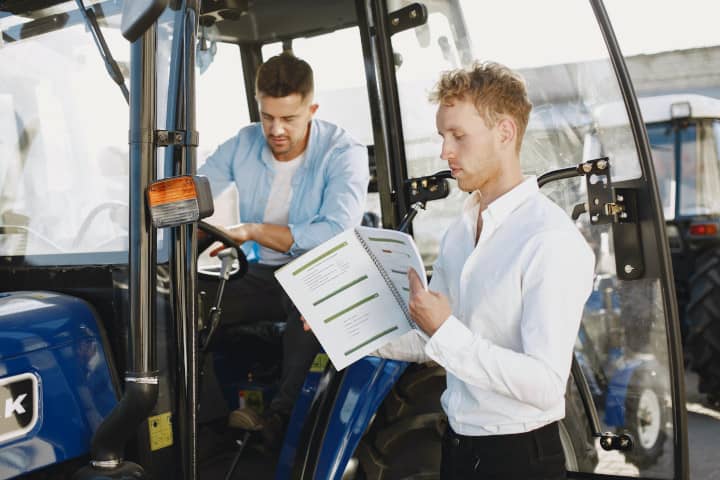Running a business can be a lot of work, but it’s also very rewarding. As you go about building your business, don’t forget to make sure you have the necessary safety documents in place. Every business is different, so make sure you speak with your state regulator or safety consultant to find out what specific documents you need. In this blog post, we’ll discuss some of the most common safety documents that businesses should have in place. Stay safe and successful!
You may have heard the term OHS which means Occupational Health and Safety or WHS which stands for Workplace Health and Safety, or maybe even HSE which stands for Health, Safety and Environment. They all basically mean the same thing but different juristrictions use different terminology. It can make it very confusing! That’s why we are sticking with ‘safety documents’ for this blog.
What are safety documents?
Safety documents are an important part of any business. They help ensure that your workplace is safe for employees, customers, and anyone else who visits. Safety documents can include things like safety policies, procedures, and plans. They can also include information on how to handle specific hazards in your workplace.
Why do I need safety documents?
Safety documents are important because they help you meet your legal obligations. In Australia, business owners have a duty of care to ensure that their workplaces are safe. This means taking reasonable steps to prevent injuries and incidents from happening.
Having detailed safety documents in place is one way to show that you’re taking your duty of care seriouslyAdditionally, safety documents can help you manage risks in your workplace. By identifying potential hazards and outlining how to deal with them, you can help make your workplace safer for everyone.
This can reduce the likelihood of accidents and incidents, and help create a positive safety culture in your business.
It’s important to note that in Australia business owners (also known as PCBUs) are required to ensure the safety of anyone who may be affected by their business. That means that you can be investigated, charged, fined or sued not only for putting your workers at risk or injuring them, but also your customers, or even just someone walking past your business. So even if you are a sole trader, you should ensure you have all the safety documents legislation requires so if something does go wrong, you have evidence that you are trying to manage your safety obligations.
Have you ever wondered why it is WorkSafe that investigates incidents such as the Dreamworld disaster or the Tasmanian school jumping castle disaster? It’s because they are considered workplaces and people were killed or injured there even if they weren’t employees. So while Dreamworld is a large company, the jumping castle company is a small business and it’s owners will be treated no differently in the eyes of the law from each other.
Also, depending on your business and what work you conduct you may be legally required to have specific types of safety documentation. For example, if you work with chemicals you may be required to have a chemical register or if you complete high risk construction work you will be required to have a Safe Work Method Statement.

What safety documents do I need for my business?
There is no one-size-fits-all answer to this question, as the safety documents you’ll need will depend on the specific type of business you run, how many employees you have, what kind of work you do and much more. However, there are some common safety documents that businesses should have in place. These include:
- A safety manual or policy: A safety manual outlines your commitment to health and safety in the workplace. It can also include things like your company’s values, how you manage particular risks, and what to do if an incident does occur and more (we’ll get more indepth further down)
- A hazard register: A hazard register is a document that lists all the potential hazards in your workplace. It can help you to identify and manage risks, and make sure that you’re taking steps to minimise the likelihood of an accident or incident occurring
- Safe work method statements (SWMS): A SWMS is a document that outlines how to safely complete a particular task. It covers things like who will be doing the task, what hazards are involved, what personal protective equipment (PPE) is needed and more. A SWMS is generally only used in construction, however more industries have recognised the benefits of them and have started implementing them.
- Incident reporting procedures: Incident reporting procedures outline what to do if an accident or incident does occur in your workplace. They can help you to quickly deal with the situation and make sure that any necessary investigations are carried out. These can often be included within the safety manual.
- Checklists: You should have a range of checklists such as workplace checklist, pre-start checklist, induction checklist and more. These checklists help you to ensure that you’re identifying hazards and risks within the workplace, and can be used as evidence if something does go wrong.
- Other registers: Depending on your business, you may be required to have other specific registers. For example, if you work with chemicals you’ll need a chemical register and if you use plant or machinery you’ll need a plant register.
- Toolbox talks: Toolbox talks are informal safety meetings where you discuss a particular safety issue with your employees. They can be used to raise awareness of hazards, share new information or just reinforce existing safety procedures. While not really a safety document they should be a part of all businesses.
- Safe Operating Procedures: Safe operating procedures (SOPs) are used to show workers how to use tools or equipment, or complete specific tasks in a safe manner.
As you can see, there is a range of different safety documents that businesses should have in place. The exact ones you’ll need will depend on your specific business and industry, so it’s important to seek professional advice to make sure you’re compliant.
Do small businesses need safety documents?
Yes. The law doesn’t make any allowances for the size of a busines, small businesses are just as susceptible to workplace accidents and incidents as larger businesses, so having comprehensive safety documentation in place can help to minimise the risks.
Of course, the smaller your business is, the less complex your safety documentation is likely to be. For example, a one-person business won’t need a induction training or toolbox talks, but they will still need to have some kind of documentation in place outlining their commitment to health and safety and how they manage the hazards and risks associated with their work.
There are many examples of small businesses around Australia being fined, or even taken to court, for failing to comply with health and safety legislation. So even if you think your business is too small to worry about safety, it’s always better to be safe than sorry. You never know when something could go wrong, or if an inspector will turn up to your business.
What are the benefits of having safety documents?
Other than meeting your legal obligations and reducing your exposure to fines and legal issues, there are many benefits to having comprehensive safety documentation in place.
Some of the benefits of having safety documents include:
Improved communication:
Safety documentation can help to improve communication between management and employees, as well as between different departments within a business. This can help to ensure that everyone is on the same page when it comes to health and safety.
Reduced risks:
By having safety documentation in place, you can help to reduce the risks associated with your work. This can lead to a safer workplace and fewer accidents and incidents.
Improved morale:
Employees who feel that their employer is committed to health and safety are more likely to be engaged and have higher morale. This can lead to improved productivity and a more positive workplace safety culture.
Better reputation:
A business with good safety documentation can develop a better reputation, both with employees and the wider community. This can lead to improved customer satisfaction and more business opportunities.
Save money:
With better communication and understanding of safe working procedures there is going to be fewer incidents requiring employees to have time off or for businesses to replace damaged equipment or property. In the long run, having comprehensive safety documentation can save businesses money.
As you can see, there are many benefits to having safety documents in place. So if you don’t have them already, now is the time to start putting together your safety documentation. If you’re unsure of what documents you need for your business, or how to create them, it’s always best to seek professional advice.

What can happen if I don’t have any safety documents?
If you don’t have any safety documentation in place, you’re putting your business at risk of a range of different legal issues.
Some of the consequences of not having safety documentation include:
Fines:
If you’re caught operating without the required safety documents, you can be fined. The amount of the fine will depend on the state or territory you’re in, but it can be up to $50,000 for an individual and $250,000 for a corporation.
Prosecution:
In some cases, businesses that don’t have safety documentation can be prosecuted. This can lead to a criminal record and/or a jail sentence.
Loss of business:
If your business is involved in an accident or incident, and it’s found that you don’t have adequate safety documentation, you could lose customers and clients. This can damage your reputation and make it difficult to attract new business.
Injuries:
If someone is injured at your workplace, and it’s found that you don’t have adequate safety documentation, you could be liable for their medical expenses and lost wages. This could end up costing your business a lot of money. Plus who wants to injure some one?? Remember it doesn’t even have to be you or a worker to be injured to be held liable.
Property damage:
If there’s an accident or incident at your workplace that results in damage to property, you will have to spend time and money fixing it. This could cost your business a lot of money, and it could disrupt your operations.
Void your insurance:
If you don’t have the required safety documentation in place, your insurance policy could be void. This means that if there’s an accident or incident at your workplace, you won’t be covered. Also, just a quick note, insurance doesn’t pay for your fines.
Even if your insurance policy isn’t voided, not having safety documentation in place can lead to an increase in your premiums. This is because you will be seen as a higher risk, and this will be reflected in the price of your insurance.
As you can see, there are a range of serious consequences that can flow from not having safety documentation in place. So if you don’t have any safety documents for your business, now is the time to get them sorted. If you’re unsure of what you need, or how to create them, it’s always best to seek professional advice.
Is it hard or complicated to implement safety documents?
No, it’s not hard or complicated to implement safety documents. However, it is important to make sure that you have the right documents in place for your business. This will depend on the type of business you have, and the risks associated with your workplace.
You also need to make sure that your safety documents are up-to-date. This means keeping them in line with any changes to the law, or to your workplace.
These things make it sound complicated, but it really isn’t. If you don’t have a high risk work environment you can set your safety up and implement it in as little as 30 minutes and then spend less than an hour a month on it. Of course you’ll need to do more if you do have a higher risk workplace but the same goes for any business, big or small.
If you’re unsure of what safety documents you need for your business, or how to create them, it’s always best to seek professional advice.
How do I implement my safety documents?
There are a few steps you need to take to implement your safety documents:
1. Decide which documents you need. This will depend on the type of business you have, and the risks associated with your workplace.
2. Create the documents. You can either do this yourself, or get help from a professional.
3. Train your employees on the documents. This is important, as they need to know what they need to do to keep themselves safe.
4. Make sure the documents are up-to-date. This means keeping them in line with any changes to the law, or to your workplace.
5. Review the documents regularly. This will help to ensure that they are still relevant, and that your employees are following them.
If you’re unsure of what safety documents you need for your business, or how to create them, it’s always best to seek professional advice.
For Safe-R Outcomes clients it’s even easier! When you purchase your package you’ll recieve immediate access to all the documents you need for your industry. Plus they are all pre-filled, you can just upload your logo and business details and then email your documents to your workers and ask them to read them and come to you with any questions. Then you can print out any documents you want in the workplace for easy access for everyone. And finally use our supporting documents such as checklists and registers as required to ensure that safety is being adhered too.
It really is that simple!
Where can I get help with safety documentation?
There are a range of places you can get help with safety documentation:
1. Safe Work Australia: Safe Work Australia provides a range of templates and tools that can help you to create safety documents for your business.
2. State and Territory governments: Each state and territory government has their own workplace health and safety agency, which can provide assistance with creating safety documents.
3. Professional associations: If you’re a member of a professional association, they may have resources that can help you to create safety documents.
4. Your local chamber of commerce: Your local chamber of commerce may be able to provide assistance with creating safety documents.
5. Safety consultants: There are a number of safety consultants who can help you to create safety documents for your business. Of course, we think we are the best 😉

How do I choose the right company for my safety documents?
There are a few things you need to consider when choosing a company to create your safety documents:
Qualifications:
The company you choose should have qualified staff who are up-to-date with the latest workplace health and safety legislation.
Experience:
The company you choose should have experience in creating safety documents for businesses like yours.
Cost:
Make sure you get a range of quotes, to ensure you’re getting the best value for money.
Support:
Choose a company that will provide support after you’ve purchased your safety documents, in case you have any questions or need any assistance.
Testimonials:
Ask the company for testimonials from other businesses they’ve created safety documents for. This will give you an idea of the quality of their work.
Ease of use:
The safety documents should be easy for you and your employees to understand and use.
Relevant:
The documents should be relevant to your business and your workplace. Also be wary of companies who try and sell you a range of documents that you don’t need. Stick to what’s relevant for your business, and you’ll save yourself time and money.
In conclusion
There are a number of safety documents that your business may need, depending on the type of business you have and the work you do. It’s important to choose a company that has qualified and experienced staff, who can provide you with the right documents for your business. Safe-R Outcomes is a leading provider of safety documents in Australia, and we’re always happy to help our clients with any questions or concerns they may have.
Of course, we think Safe-R Outcomes is the best choice for safety documents, but we’re biased! We have a team of qualified and experienced staff, who are always happy to help our clients with any questions or concerns they may have. Plus, our safety documents are easy to use and understand, and are backed up by our outstanding customer service.
So why not give us a try? We think you’ll be glad you did!


